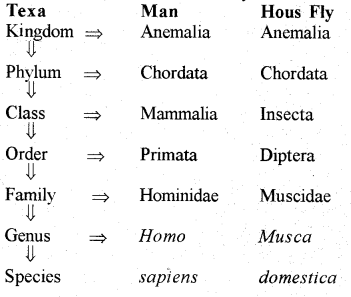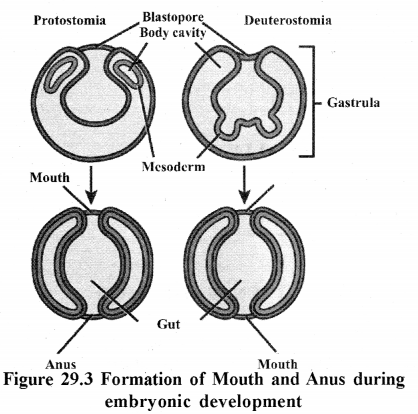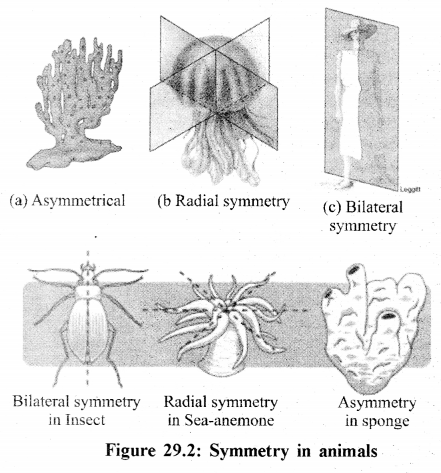Rajasthan Board RBSE Class 11 Biology Chapter 29 Classification of Animals
RBSE Class 11 Biology Chapter 29 Multiple Choice Objective Questions
Question 1.
The branch of zoology that deals with the classification and its evolutionary relations-
1. Physiology
2. Histology
3. Morphology
4. Taxonomy
Question 2.
Smallest unit of animal classification
1. Genus
2. Phylum
3. Species
4. Order
Question 3.
The three texa in the trinomial nomenclature are respectively-
1. Genus → Species → Subspecies
2. Genus → Order → Class
3. Class → Genus → Species
4. Order → Genus → Class
Question 4.
Father of modern classification-
1. D. Condelle
2. Hucker
3. Hutchison
4. Linnaeus
Question 5.
Which of the following exhibits least similarities-
1. Class
2. Genus
3. Species
4. Family
Answers :
(1). 4
(2). 3
(3). 1
(4). 4
(5). 1
RBSE Class 11 Biology Chapter 29 Very Short Answer Questions
Question 1.
Which phylum shows cellular grade of organization?
Answer :
Porifera
Question 2.
Which type of symmetry is found in the chordates.
Answer :
Bilateral
Question 3.
The animals in which the blastopore forms anus are called?
Answer :
Deuterostomia
Question 4.
In animal, the true coelom first appeared in which phylum.
Answer :
Annelida
Question 5.
Who is called as father of zoology
Answer :
Aristotle
Question 6.
The branch of science that deals with the animals.
Answer :
Zoology
Question 7.
The two parts in binomial nomenclature stands for what?
Answer :
Genus, Species
Question 8.
The scientific name of Indian crow.
Answer :
Corvus splendens splendens
Question 9.
Mammals are kept in which kingdom of five kingdom classification.
Answer :
Anemalia
Question 10.
Which science deals with the inter relationship among morphological features, evolutionary development, variations among animals and animal fossils.
Answer :
Systematics
Question 11.
The triploblastic phylum which is without coelom.
Answer :
Platyhelminthese
Question 12.
Write the names of three germ layers found in the animals.
Answer :
Ectoderm, mesoderm & endoderm.
RBSE Class 11 Biology Chapter 29 Short Answer Questions
Question 1.
Given the modem definition of “Species”
Answer :
Species: It is the smallest unit of classification it is a group of similar animals which can interbreed to produce fertile offspring. Sometimes, animals of one species develop dissimilarities due to geographical and environmental variations. Now, the species is divided into subspecies. The members of a specific species are/can-
- Similar in morphology
- Interbreed to produce fertile offspring
- Originated from same parents.
Question 2.
Define “taxonomy”.
Answer :
The study of principals and the framing of the rules for classification is called as taxonomy.
Question 3.
Given an account of two kingdom classification of organisms.
Answer :
This system was later adopted by Carolus Linnaeus (1707-1778), who is now called as “father of taxononmy”. He published this scheme of classification in his famous book “Systema Naturae” (1735). He classified living objects into 2 kingdoms-Animalia & Plantae. He further divided each kingdom into classes, a class was again divided into orders and order into genera. Finally, each genus includes one or more species.
Question 4.
Write two salient features of kingdom protista.
Answer :
Unicellular, Eunucleus, protozoans
Question 5.
Write the texa of classification in sequence with examples.
Answer :
Kingdom: It is the largest texon in classification. All the animals are kept under kingdom “Anemalia” and plants under kingdom “Plantae”. For example, the hierarchy of classification of man & house fly is as follows:

Question 6.
Write the names of five kingdom of the organisms.
Answer :
Monera, Protista, Plantae, Fungie, Animalia
Question 7.
Differentiate acoelomate & pseudocoelomate.
Answer :
- Acoelomate: The animals without any cavity between ectoderm and endoderm. There are mesenchyma tissues (mesodermal in origin) between ec-toderm & endoderm.
Example- Platyhelminthese. - Pseudocoelomate: They have a body cavity between ectoderm and endoderm but it is not lined by the mesoderm.
Example- Aschelminthese
Question 8.
Write the names of the groups of animals on the basis of body cavity.
Answer :
Coelom: The coelom is a body cavity which develops during embry onic development of an animal between ectoderm & endoderm, and it may or may not be lined by mesoderm or it may be absent in some animals. The presence absence & type of coelom is also a basic feature used in animal classification
- Acoelomate
- Pseudocoelomate
- Eucoelomate
RBSE Class 11 Biology Chapter 29 Essay Type Questions
Question 1.
What is binomial nomenclature? Explain with the help of examples.
Answer :
Binomial nomenclature :
Caroius Linnaeus (1758) propounded a modem system of nomenclature which is called as binomial nomenclature. It was published in the 10th edition of his book Systema Naturae. According to it-
- The scientific name of an animal has two parts. The first part denotes genus of the animal & called as generic name. The second part denotes species of the animal and is known as specific name.
- The scientific name is written in Latin i.e. the scientific name be latinized.
- The scientific name must be written in italics or underlined separately.
- The generic name begins with capital letter while the first letter of the specific name must be small.
- The name of discoverer or author if present should appear after the specific name. It should not be italicized.
- Generic & specific names may be same such as Catla catla & Gorilla gorilla. Common & generic names may be similar, such as Gorilla is the generic name of gorilla.
Example :
| Common name | Scientific name | First name (Genus) |
Second name (Species) |
| 1. Frog | Rana tigrina | Rana | tigrina |
| 2. Elephant | Elephas indicus |
Elephas | indicus |
Question 2.
Given an account of rules given by International congress for the nomenclature of the animals.
Answer :
International code of nomenclature :
In 1898, international congress established a commission to frame international code of Botanical and Zoological nomenclature. This commission suggested some rules in 1901 which were modified in 1964.
- The zoological name (scientific name) should be Latinized
- Every animal is to be given a zoological name according to binomial system/trinomial system.
- The first letter of genus name should always be capital.
- The first letter of species name should always be small.
- The scientific name should be printed in Italics or underlined separately.
- The name of subspecies, if any, always comes after the species name.
- If many scientific names have been given to the same animal by different authors, the name used prior to those included by Linnaeus in “Systema Naturae,” 10th edition (1758) is considered valid.
- The name of discoverer if any, appears at the end of the scientific name.
- The two genera should not have same name & similarity two species in a genus. However, species name may figure many times but each time with a separate genus. For example Elephas indicus (Indian elephant) & Bos indicus (cow).
- Suffix idae should be added in the name of genus to create family and suffix inae should be added in the name of genus to create sub-family.
Question 3.
Explain the process of formation of coelom with the help of labelled diagram.
Answer :
Coelom :
The coelom is a body cavity which develops during embryonic development of an animal between ectoderm & endoderm, and it may or may not be lined by mesoderm or it may be absent in some animals. The presence absence & type of coelom is also a basic feature used in animal classification –
- Acoelomate: The animals without any cavity between ectoderm and endoderm. There are mesenchyma tissues (mesodermal in origin) between ectoderm & endoderm.
Example- Platyhelminthese. - Pseudocoelomate: They have a body cavity between ectoderm and endoderm but it is not lined by the mesoderm.
Example- Aschelminthese - Eucoelomate: They have a body cavity between ectoderm and endoderm which is lined by the mesoderm. It is also c/a true coelom and its is of two types of the basis of origin
(a) Schizocoelomate: The true coelom which is formed by the splitting of the mesoderm during embryonic development. The measoderm along with ectoderm (Body wall) is called as somatic mesoderm and with endodenn (Alimentary canal) is c/a splanchnic mesoderm.
Example- Annelida, Arthropoda, Mollusca.
(b) Enterocoelomate: The true coelom which is formed as a pouch from the endodenn, similarity, the mesoderm layer with ectoderm is c/a somatopleur and with endoderm as splanchnopleur.
Example- Echinodermata. Chordata

Question 4.
Explain how the symmetry helps in the classification of animals?
Answer :
Symmetry :
The animals exhibit from callular grade of organisation upto tissue grade, organ grade & organ system grade of organisation. These animals exhibit different type of symmetry such as
- Asymmetrical: When the animal body can’t be divided into two equal parts by any longitudinal cut.
Example- Sponge (Phylum-Porifera) - Radial Symmetrical: When the animal body can be divided into two equal parts with the help of any longitudinal cut.
Example- Hydra, sea Anenone (Phylum-Co-elenterata) - Bilateral Symmetrical: When the animal body can be divided into two equal parts only by a specific longitudinal cut.
Example- Man, Insect, Butterfly, Frog, Platyhelminthese etc.

Question 5.
Describe in brief the basic features used in animal classification.
Answer :
Basis of Classification of Animals :
The history of the classification is very old. Initially, we classified the plants and animals on their value or utility to man such as useful – harmful, dangerous-non dangerous, edible-inedible. The plant and animal kingdom were differentiated on the basis of cell wall, chlorophyll and nutritional methods.
Taxonomists classified the animals on the basis of certain salient features. The normal five basic features are as follows:-
1. Symmetry :
The animals exhibit from cellular grade of organisation up to tissue grade, organ grade & organ system grade of organisation. These animals exhibit different type of symmetry such as
- Asymmetrical: When the animal body can’t be divided into two equal parts by any longitudinal cut.
Example- Sponge (Phylum-Porifera) - Radial Symmetrical: When the animal body can be divided into two equal parts with the help of any longitudinal cut.
Example- Hydra, sea Anenone (Phylum-Co-elenterata) - Bilateral Symmetrical: When the animal body can be divided into two equal parts only by a specific longitudinal cut.
Example- Man, Insect, Butterfly, Frog, Platyhelminthese etc.

2. Germ Layers :
In the embryonic development of the multi cellular animals, the fertilization is followed by cleavage which results in the formation of blastula and gastrula. The gastrula develops two or three germ layers viz- ectodern, mesoderm and endoderm. These germ layers form various body organs. It is one of the basic feature used in animal classification as—
- Diploblastic: The animals winch exhibits two germ layers viz – ectoderm and endoderm Example- Phylum – coelenterata
- Triploblastic: The animals which develop from three-layered gastrula viz. ectoderm, mesoderm and endoderm.
Example- Phylum – platyhelminthese to phylum Chordata.
3. Coelom :
The coelom is a body cavity which develops during embryonic development of an animal between ectoderm & endoderm, and it may or may not be lined by mesoderm or it may be absent in some animals. The presence absence & type of coelom is also a basic feature used in animal classification –
- Acoelomate: The animals without any cavity between ectoderm and endoderm. There are mesenchyma tissues (mesodermal in origin) between ectoderm & endoderm.
Example- Platyhelminthese. - Pseudocoelomate: They have a body cavity between ectoderm and endoderm but it is not lined by the mesoderm.
Example- Aschelminthese - Eucoelomate: They have a body cavity between ectoderm and endoderm which is lined by the mesoderm. It is also c/a true coelom and its is of two types of the basis of origin
(a) Schizocoelomate: The true coelom which is formed by the splitting of the mesoderm during embryonic development. The measoderm along with ectoderm (Body wall) is called as somatic mesoderm and with endodenn (Alimentary canal) is c/a splanchnic mesoderm.
Example- Annelida, Arthropoda, Mollusca.
(b) Enterocoelomate: The true coelom which is formed as a pouch from the endodenn, similarity, the mesoderm layer with ectoderm is c/a somatopleur and with endoderm as splanchnopleur.
Example- Echinodermata. Chordata

4. Segmentation :
The body of many animals consist of few to many segments. They are formed normally during embryonic development and the process is called as segmentation. The segmentation is also a basic feature of animal classification and on this basis animals are divided into 3 groups viz-
- Nonsegmented body:- The body of some animals is not divided into segments.
Examples- Porifera. Coelenterata, Aschelminthese etc. - Pseudosegmented body: The body of some animals is pseudosegmented.
Example- Tape worms (Platyhelmmthese) - True Segmented body: The body of some animals exhibit true segmentation which is also called as metameric segmentation.
Example- Annelida, Arthropoda